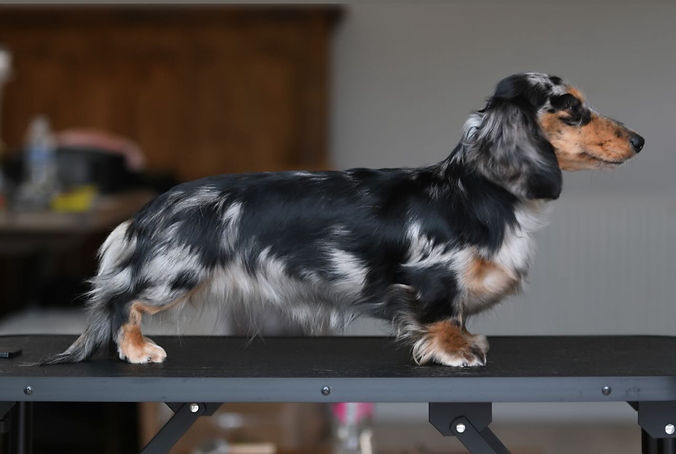
The Breed Standard
What is the breed standard and why does it matter?
The Dachshund is a breed with centuries of history behind it, and both the Kennel Club (KC) in the UK and the Fédération Cynologique Internationale (FCI) internationally hold detailed breed standards to preserve that heritage. These standards are not just about appearance, they safeguard health, soundness, and temperament, ensuring Dachshunds remain true to type and capable of living active, fulfilling lives.
What Should a Dachshund Look Like?
According to both the KC and FCI, a Dachshund should be:
-
Low, long, and compact, with a strong, muscular body - never exaggerated to the point of weakness.
-
Balanced and proportionate, with enough ground clearance to move freely and without restriction.
-
A proud, noble head carriage, tapering but clean, with almond-shaped eyes that show intelligence and alertness.
-
A long ribcage providing room for strong lungs and heart, with a straight backline - not sagging or roached.
-
Strong legs and feet, with front paws slightly turned out, built for digging, and hindquarters that provide drive and balance.
-
Free, purposeful movement, covering ground efficiently, not mincing or restricted.
-
A bold temperament - courageous but not aggressive, affectionate yet independent, always full of character.
Why the Standard Matters
The KC and FCI standards are a blueprint for the breed. They exist to stop exaggerations, unhealthy trends, and “fashion breeding” from diluting what makes the Dachshund special. Without them, the breed risks drifting into novelty rather than function.
At Deliciaedax, we are proud to breed to both KC and FCI standards, carefully selecting our dogs so they embody the best of the breed: sound in structure, true in type, and steady in temperament. Our Dachshunds are not only beautiful, but built to live happy, healthy lives - just as the standard intended.
KC vs FCI Breed Standards
Both the Kennel Club (UK) and the FCI / World Union Teckel (WUT) share the same vision of what a Dachshund should be, but there are subtle differences in emphasis. These differences explain why Dachshunds may appear slightly different in type depending on whether they are bred to KC or FCI standards.
Size / Proportion
Kennel Club (UK): Two sizes - Standard and Miniature.
Miniatures should weigh under ~5 kg. No strict maximum height, but they must have enough ground clearance for free movement. Described as “moderately long and low with no exaggeration, compact, well-muscled body.”
FCI / WUT (International): Three sizes - Standard, Miniature, and Kaninchen (Rabbit Dachshund). Sizes are defined by chest circumference (measured at 15 months or older):
-
Kaninchen: up to 30 cm (Dogs), up to 28 cm (Bitches)
-
Miniature: 30–35 cm (Dogs), 28–33 cm (Bitches)
-
Standard: over 35 cm (Dogs), over 33 cm (Bitches)
Proportion is carefully controlled, with less extreme length-to-height ratios than the KC. Greater emphasis on balance and ground clearance.
Ground Clearance
Kennel Club (UK): “Body sufficiently clear of the ground to allow free movement.” No fixed numeric ratio.
FCI / WUT (International): More precise by implication - many interpretations require about one third ground clearance. Dogs with insufficient clearance are considered faulty.
Length : Height (Body Proportion)
Kennel Club (UK): Traditionally illustrated as a 2:1 ratio (body length about double the height at withers). Modern guidance stresses “moderately long” while avoiding over-exaggeration.
FCI / WUT (International): Body length to height at withers: The FCI specifies a ratio of approximately 1.7–1.8 : 1 (length : height). So, the Dachshund should be longer than tall, but not pushed to the extreme 2:1 ratio often seen in the UK.
Coats & Colours
Kennel Club (UK): Acceptable colours (Smooth/Long/ Wire):
-
Solid red (with or without shading)
-
Cream (clear or shaded)
-
Black & tan, chocolate & tan
-
Dapple (silver dapple most common, with dark overlay and tan points)
-
Acceptable in Wires only: Wild boar, red, chocolate & tan
-
Patterns: Dapple, brindle (in all coat types)
Faults/undesirable:
-
Large areas of white (a small patch on chest is permissible but not desirable)
-
Blue, isabella/lilac (dilutes) – considered undesirable and discouraged under the colour clause
-
Any excessively mismarked dog (e.g. too much white, double dapple patterning causing health risk)
-
KC stance: Stronger emphasis on discouraging dilute colours (blue, isabella) due to associated health issues (alopecia, skin problems).
FCI / WUT (International): Acceptable colours (Smooth/Long):
-
One-colour: red, reddish-yellow, yellow (with or without black overlay)
-
Two-colour: deep black, chocolate, or grey-blue with rust or tan markings
-
Dapple (merle): base colour is always dark (black, red, grey, chocolate), with irregular patches of lighter shades
-
Wire-haired special colour: Wild boar (most typical), light to dark shades
-
Patterns: Dapple, brindle (though brindle is rarer in FCI countries, still recognised)
Faults/undesirable:
-
White not desired (except a small chest patch tolerated)
-
Strongly defined, irregular white markings are disqualifying
-
Dilute colours are not standard and may be disqualified depending on country (e.g. blue, isabella, extreme piebald)
-
Double dapple (seen as a disqualifying fault due to risk of deafness/eye defects)
Faults / Exaggerations
Kennel Club (UK): Warns against exaggerations: too low, too long, overly deep chest, or excessively short legs. Dogs should always be “moderately long and low, with no exaggeration.”
FCI / WUT (International): Lists eliminating faults in detail: weak loins, chest trailing on the ground, poor angulation, or extreme proportions. Strong emphasis that Dachshunds must be fit for function and capable of free movement.


